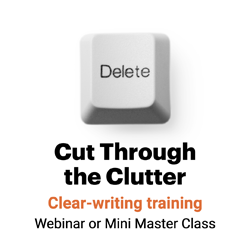4 ways to find your focus
My favorite scene in “Planes, Trains and Automobiles” is when Steve Martin finally blows his stack at John Candy’s irritating character.

The thing that finally sends Martin over the edge isn’t when he finds he’s washed his face with Candy’s dirty underwear. It isn’t even when he wakes up to discover that he and Candy are snuggling together in the hotel room’s only bed.
The thing that finally breaks Martin’s character is when Candy tells a story that rambles on and on and on — without coming to any clear conclusion. And Steve Martin splutters as only Steve Martin can:
“Here’s an idea: Have a point!”
I often think of that line when I’m writing and editing. “Here’s an idea: Have a point!”
Take a tip from The New York Times: An interesting story needs an interesting angle. It needs a point of view. It needs focus.
Why find your focus?
Finding your focus is one of the three main ways to cut your copy. From best to worst, they are:
- Selection, or tightening your story angle
- Redirection, or breaking the story into multiple pieces
- Compression, or editing the piece down
Why is selection, or finding your focus, the best way to condense your copy? Because the best pieces are an inch wide and a mile deep: They cover a small topic, but they do so fully and colorfully.
Edit before you write.
I was reminded of the importance of starting with a tight story angle recently when the editor of an airline magazine asked me to write a piece about Kansas City.
“Kansas City,” I said. “Would that be Kansas City barbecue? An insider’s guide to where the bodies are buried? The perfect weekend for lovers? Kansas City on the quick, on the cheap or for the family?”
“Yup,” she said. “Kansas City.”
Well, I know Kansas City. I lived there for 30 years, and I covered it from my desk as a magazine editor for nearly five. But I’ve never toiled so hard on a simple piece. And I’ve never been so disappointed in the results.
Might as well ask me to write 900 words on traveling to the United States.
My problem, of course, was that my copy lacked focus. And a lack of focus makes it difficult for you — and for your reader — to get through your story.
How to find your focus
To find your focus before you write, follow these four steps:
1. Focus on a single idea.
You can communicate one idea well, a handful poorly or several not at all.
Think of your piece as a tree. Your story angle is the trunk. The tree can branch out in several directions, but when you find a sapling, yank it out. Don’t tie a rope from the sapling to your tree and call it a branch.
2. Summarize your idea in a single sentence.
As one of my favorite college professors used to say: “If you can’t summarize your story idea on the back of my business card, you don’t have a clear idea.”
Your summary sentence will keep you from getting scattered and from including information that isn’t pertinent to the copy.
3. Make your point.
Use your summary sentence as the basis for your:
- Headline or deck
- Lead or nut paragraph
- Blurb for index or table of contents
4. Test for focus.
Finally, make sure every paragraph, every sentence and every word in your piece work together to support your theme.
To test this, reread your copy with your tight story angle in mind. With each sentence, don’t just ask, “Does this sentence work?” Also ask: “Does this sentence work to further my point?”
Focus has more to do with what you eliminate from your piece than with what you leave in it. So if a section, paragraph or sentence doesn’t pass the test, take it out.
That’s focus.
Tighten your angle after you write.
“It’s easier to whack an entire paragraph than a single word,” writes Chip Scanlan, The Poynter Institute’s writing workshop director.
Cut sections, not syllables.

Leave a Reply